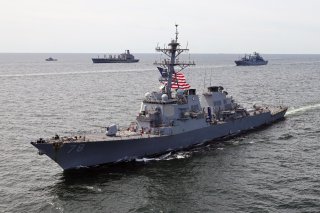Next-Generation SPY-6 Radars Will Help the Navy Fight Wars of the Future
The idea with SPY-6 radar is to give ship commanders more time and decisionmaking abilities by identifying approaching threats and enemy attacks more precisely and at much farther distances.
The U.S. Navy’s new generation of SPY-6 radars is being engineered to prepare the service to contend with a number of new, longer-range threats and a more widely dispersed force armed with precision weaponry and robust, multi-domain networking. Differently scaled variants of the new radar technology are being integrated across the force, including on the Navy’s aircraft carriers, destroyers, and amphibious warships, to accommodate various mission requirements. The most-sensitive SPY-6 radar, the V(1), is being built into new Navy DDG 51 Flight III destroyers while alternate radars for air surveillance, such as the Enterprise Air Surveillance Radar (EASR), are being built onto amphibious assault ships and aircraft carriers. The EASR radars are also part of the SPY-6 family, yet tailored with the number of Radar Module Assemblies needed to perform its specific mission.
The SPY-6 (V)2, for instance, is a smaller rotating radar while the SPY-6 (V)3 has three fixed radar faces on the deck houses. These variants will go on both Nimitz-class and Gerald R. Ford-class carriers. The (V)3 has nine radar module assemblies and three fixed spaces looking out at a different angle, covering 360 degrees with 120-degree panels. Finally, there is a SPY-6 (V)4 which will be integrated onto existing DDG 51 Flight IIA destroyers during a mid-life upgrade. The (V)4 has twenty-four Radar Module Assemblies, compared to the (V)1, which has thirty-seven.
The SPY-6 family moves beyond existing AN/SPY-1 ship-integrated radar systems and, according to an interesting essay in Microwave Journal, “...handles 30 times more targets and has 30-times greater sensitivity than the SPY-1D(V).”
The AN/SPY 6 family of radars is a next-generation, highly-sensitive, ship-integrated threat detection system designed to track multiple approaching missile, rocket, drone, or aircraft threats on a single, highly-sensitive threat detection radar system. SPY-6 radar systems, combined with fire control and an advanced software-ballistic missile defense system called Aegis Baseline 10, set the technical foundation for the fleet.
Discrimination is, of course, a vital advantage associated with increased radar sensitivity, as it can discern threat objects from other less-relevant items such as friendly platforms or flying debris. The use of a scalable antenna, composed of 2ft x 2ft x 2ft Radar Module Assembly building blocks, has enabled developers to engineer tailored, mission-specific, SPY 6 radar applications for different platforms.
The idea with SPY-6 radar is to give ship commanders more time and decisionmaking abilities by identifying approaching threats and enemy attacks more precisely and at much farther distances. This phenomenon is of great relevance in today’s global threat environment wherein potential adversaries are quickly developing longer-range precision weaponry and electronic warfare systems. Giving commanders increased response time, especially when under attack, can save sailors’ lives, multiply offensive and defensive mission possibilities, and result in preferred mission outcomes.
Kris Osborn is the Defense Editor for the National Interest. Osborn previously served at the Pentagon as a Highly Qualified Expert with the Office of the Assistant Secretary of the Army—Acquisition, Logistics & Technology. Osborn has also worked as an anchor and on-air military specialist at national TV networks. He has appeared as a guest military expert on Fox News, MSNBC, The Military Channel, and The History Channel. He also has a Master's Degree in Comparative Literature from Columbia University.
Image: Flickr.

